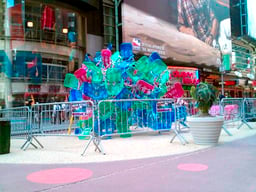Times Square
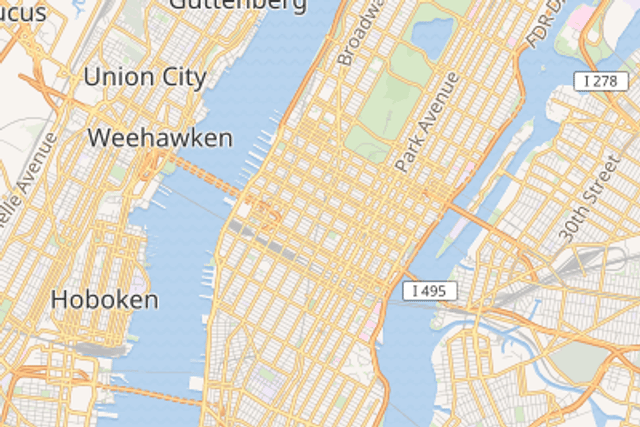
Times Square

Times Square | |
|---|---|
Neighborhood in Manhattan | |
 | |
| Nickname(s): The Great White Way The Crossroads of the World | |
| Coordinates:40°45′25″N 73°59′10″W [129] | |
| State | New York |
| City | New York City |
| Borough | Manhattan |
| Boundaries | Broadway, 7th Avenue, 42nd and 47th Streets |
| Subway services | 1, 2, 3,7,<7>, A, C, E,N, Q, R, W, andStrains at Times Square–42nd Street station |
| Bus routes | M7, M20, M42, M50, M104 |
| Historical features | Duffy Square George Michael Cohan statue One Times Square |
Times Square is a major commercial intersection, tourist destination, entertainment center and neighborhood in the Midtown Manhattan section of New York City at the junction of Broadway and Seventh Avenue. It stretches from West 42nd to West 47th Streets.[1] Brightly adorned with billboards and advertisements, Times Square is sometimes referred to as "The Crossroads of the World",[2] "The Center of the Universe",[3] "the heart of The Great White Way",[4][5][6] and "the heart of the world".[7] One of the world's busiest pedestrian areas,[8] it is also the hub of the Broadway Theater District[9] and a major center of the world's entertainment industry.[10] Times Square is one of the world's most visited tourist attractions, drawing an estimated 50 million visitors annually.[11] Approximately 330,000 people pass through Times Square daily,[12] many of them tourists,[13] while over 460,000 pedestrians walk through Times Square on its busiest days.[7]
Formerly known as Longacre Square, Times Square was renamed in 1904 after The New York Times moved its headquarters to the then newly erected Times Building – now One Times Square – the site of the annual New Year's Eve ball drop which began on December 31, 1907, and continues today, attracting over a million visitors to Times Square every year.[14][15]
Times Square functions as a town square, but is not geometrically a square; it is closer in shape to a bowtie, with two triangles emanating roughly north and south from 45th Street,[16] where Seventh Avenue intersects Broadway. Broadway runs diagonally, crossing through the horizontal and vertical street grid of Manhattan laid down by the Commissioners' Plan of 1811, and that intersection creates the "bowtie" shape of Times Square.[17]
The southern triangle of Times Square has no specific name,[18] but the northern triangle is called Father Duffy Square. It was dedicated in 1937 to Chaplain Francis P. Duffy of New York City's U.S. 69th Infantry Regiment and is the site of a memorial to him, along with a statue of George M. Cohan,[19] as well as the TKTS reduced-price ticket booth run by the Theatre Development Fund. Since 2008, the booth has been backed by a red, sloped, triangular set of bleacher-like stairs, which is used by people to sit, talk, eat, and take photographs.
Times Square | |
|---|---|
Neighborhood in Manhattan | |
 | |
| Nickname(s): The Great White Way The Crossroads of the World | |
| Coordinates:40°45′25″N 73°59′10″W [129] | |
| State | New York |
| City | New York City |
| Borough | Manhattan |
| Boundaries | Broadway, 7th Avenue, 42nd and 47th Streets |
| Subway services | 1, 2, 3,7,<7>, A, C, E,N, Q, R, W, andStrains at Times Square–42nd Street station |
| Bus routes | M7, M20, M42, M50, M104 |
| Historical features | Duffy Square George Michael Cohan statue One Times Square |
History
Early history
When Manhattan Island was first settled by the Dutch, three small streams united near what is now 10th Avenue and 40th Street. These three streams formed the "Great Kill" (Dutch: Grote Kil). From there the Great Kill wound through the low-lying Reed Valley, known for fish and waterfowl[20] and emptied into a deep bay in the Hudson River at the present 42nd Street.[21] The name was retained in a tiny hamlet, Great Kill, that became a center for carriage-making, as the upland to the south and east became known as Longacre.[22]
Before and after the American Revolution, the area belonged to John Morin Scott, a general of the New York militia, in which he served under George Washington. Scott's manor house was at what is currently 43rd Street, surrounded by countryside used for farming and breeding horses. In the first half of the 19th century, it became one of the prized possessions of John Jacob Astor, who made a second fortune selling off lots to hotels and other real estate concerns as the city rapidly spread uptown.[23]
By 1872, the area had become the center of New York's horse carriage industry. The locality had not previously been given a name, and city authorities called it Longacre Square after Long Acre in London, where the horse and carriage trade was centered in that city.[24] William Henry Vanderbilt owned and ran the American Horse Exchange there. In 1910 it became the Winter Garden Theatre.[25]
As more profitable commerce and industrialization of Lower Manhattan pushed homes, theaters, and prostitution northward from the Tenderloin District, Long Acre Square became nicknamed the Thieves Lair for its rollicking reputation as a low entertainment district. The first theater on the square, the Olympia, was built by cigar manufacturer and impresario Oscar Hammerstein I.[26] According to Gotham: A History of New York City to 1898, "By the early 1890s this once sparsely settled stretch of Broadway was ablaze with electric light and thronged by crowds of middle- and upper-class theatre, restaurant and cafe patrons."[27]
1900s–1930s
In 1904, New York Times publisher Adolph S. Ochs moved the newspaper's operations to a new skyscraper on 42nd Street at Longacre Square, on the site of the former Pabst Hotel, which had existed on the site for less than a decade since it opened in November 1899.[28] Ochs persuaded Mayor George B. McClellan Jr. to construct a subway station there, and the area was renamed "Times Square" on April 8, 1904.[29] Just three weeks later, the first electrified advertisement appeared on the side of a bank at the corner of 46th Street and Broadway.[30] The north end later became Duffy Square, and the former Horse Exchange became the Winter Garden Theatre, constructed in 1911.[31]
The New York Times moved to more spacious offices one block west of the square in 1913 and sold the building in 1961.[29] The old Times Building was later named the Allied Chemical Building in 1963.[32] Now known simply as One Times Square, it is famed for the Times Square Ball drop on its roof every New Year's Eve.
In 1913, the Lincoln Highway Association, headed by entrepreneur Carl G. Fisher, chose the intersection of 42nd Street and Broadway (at the southeast corner of Times Square) to be the Eastern Terminus of the Lincoln Highway. This was the first road across the United States, which originally spanned 3,389 miles (5,454 km) coast-to-coast through 13 states to its western terminus in Lincoln Park in San Francisco, California.[33][34]
Times Square grew dramatically after World War I.[35] It became a cultural hub full of theatres, music halls, and upscale hotels.[35]
Times Square quickly became New York's agora, a place to gather to await great tidings and to celebrate them, whether a World Series or a presidential election.— James Traub, The Devil's Playground: A Century of Pleasure and Profit in Times Square
Advertising also grew significantly in the 1920s, growing from $25 million to $85 million over the decade.[36] For example, the Wrigley Spearmint Gum sign, possibly the biggest electric sign "in the world," cost $9,000 per month to rent.[37] Some contemporary critics, such as Thorstein Veblen[38] and G. K. Chesterton,[39] disliked the advertising at Times Square. Fritz Lang, after seeing Times Square in 1923, used it as inspiration for his dark industrial film Metropolis.[38]
Entertainment icons such as Irving Berlin, Charlie Chaplin, and Fred Astaire were closely associated with Times Square in the 1910s, 1920s, and 1930s. However, it was also during this period that the area began to be besieged by crime and corruption, in the form of gambling and prostitution; one case that garnered huge attention was the arrest and subsequent execution of police officer Charles Becker.[40]
1930s–1950s

Crowds celebrating in Times Square on V-J Day (August 15, 1945)
The general atmosphere of Times Square changed with the onset of the Great Depression in the early 1930s. City residents moved uptown to cheaper neighborhoods, and many popular theaters closed, replaced by saloons, brothels, "burlesque halls, vaudeville stages, and dime houses".[41] The area acquired a reputation as a dangerous and seedy neighborhood in the following decades.[42]
Nevertheless, Times Square continued to be the site of the annual ball drop on New Year's Eve. The ball drop was placed on hiatus for New Year's Eve in 1942 and 1943 due to lighting restrictions during World War II. Instead, a moment of silence was observed at midnight in Times Square, accompanied by the sound of chimes played from sound trucks.
On May 8, 1945, a massive crowd celebrated Victory in Europe Day in Times Square;[43] and on August 15, 1945, the largest crowd in the history of Times Square gathered to celebrate Victory over Japan Day.[44] The victory itself was announced by a headline on the "zipper" news ticker at One Times Square, which read "*** OFFICIAL TRUMAN ANNOUNCES JAPANESE SURRENDER ***", the six asterisks representing the branches of the U.S. Armed Forces.[45]
1960s–1980s
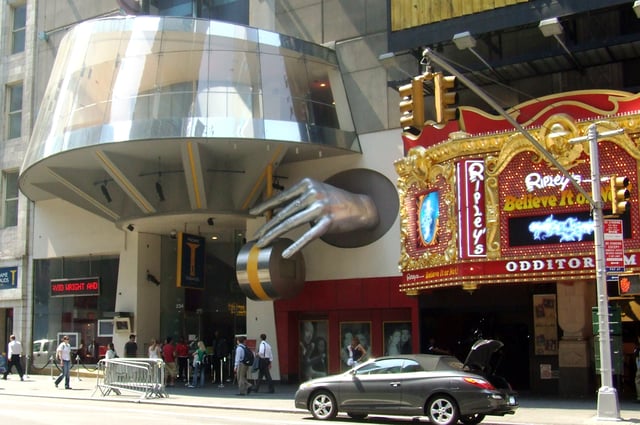
Madame Tussauds Wax Museum and Ripley's Believe It or Not! Odditorium are two of the newer attractions on the redeveloped 42nd Street.
From the 1960s to the early 1990s, the seediness of the area, especially due to its go-go bars, sex shops, peep shows and adult theaters, became an infamous symbol of the city's decline.[46]
As early as 1960, 42nd Street between Seventh and Eighth Avenue was described by The New York Times as "the 'worst' [block] in town".[47] Later that decade, Times Square was depicted in Midnight Cowboy as gritty, dark and desperate, and conditions only worsened in the 1970s and 1980s, as did the crime in the rest of the city. By 1984, an unprecedented 2,300 annual crimes occurred on that single block, of which 460 were serious felonies such as murder and rape.
At the time, police morale was low and petty criminals who committed misdemeanors were not being arrested. William Bratton, who was appointed New York City Police Commissioner in 1994 and again in 2014, stated, "The [NYPD] didn't want high performance; it wanted to stay out of trouble, to avoid corruption scandals and conflicts in the community. For years, therefore, the key to career success in the NYPD, as in many bureaucratic leviathans, was to shun risk and avoid failure. Accordingly, cops became more cautious as they rose in rank, right up to the highest levels."[48] The city government did not implement broken windows theory at first, and the allowance of low-profile crime was thought by some at the time to have caused more high-profile crimes to occur.[49] Formerly elegant movie theaters began to show porn, and hustlers were common.[50] The area was so abandoned at one point during the time that the entire Times Square area paid the city only $6 million in property taxes, which is less than what a medium-sized office building in Manhattan typically would produce in tax revenue today in 1984 dollars.
In the 1980s, a commercial building boom began in the western parts of Midtown as part of a long-term development plan developed under Mayors Ed Koch and David Dinkins.
1990s
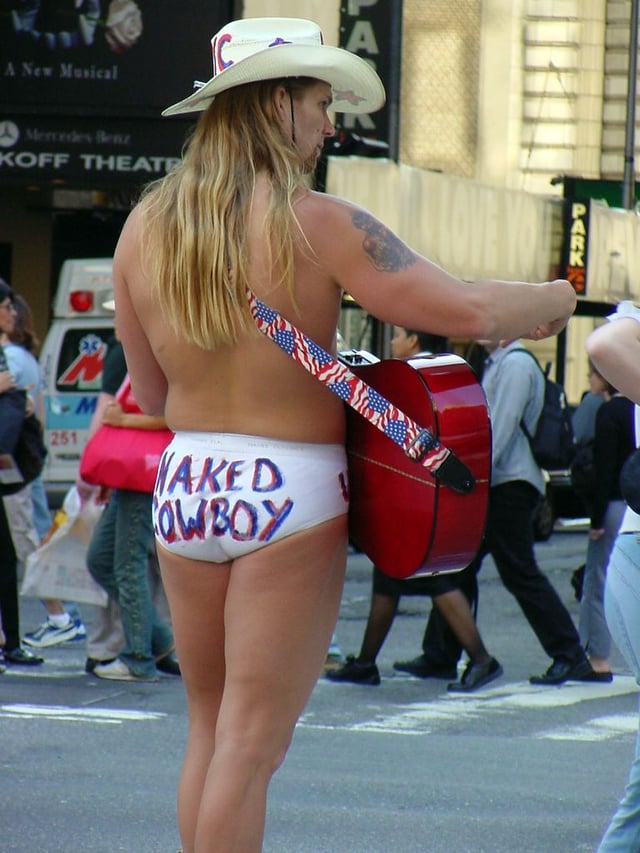
The "Naked Cowboy" – who is not actually naked – has been a fixture on Times Square for decades.
In 1990, the State of New York took possession of six of the nine historic theatres on 42nd Street, and the New 42nd Street non-profit organization was appointed to oversee their restoration and maintenance. The theatres underwent renovation for Broadway shows, conversion for commercial purposes, or demolition.[51]
In 1992, the Times Square Alliance (formerly the Times Square Business Improvement District, or "BID" for short), a coalition of city government and local businesses dedicated to improving the quality of commerce and cleanliness in the district, started operations in the area.[52]
In the mid-1990s, Mayor Rudolph Giuliani led an effort to clean up the area, an effort that is described by Steve Macek in Urban Nightmares: The Media, the Right, And the Moral Panic Over the City: Security was increased, pornographic theatres were closed, and “undesirable” low-rent residents were pressured to relocate, and then more tourist-friendly attractions and upscale establishments were opened. Advocates of the remodeling claim that the neighborhood is safer and cleaner. Detractors have countered that the changes have homogenized or "Disneyfied" the character of Times Square and have unfairly targeted lower-income New Yorkers from nearby neighborhoods such as Hell's Kitchen.[53][54] The changes were shaped in large part by the actions of The Walt Disney Company, which bought and restored the New Amsterdam Theatre's after several attempts at redevelopment had failed. As part of a contract with Disney, officials from the city and state evicted the pornographic theaters and contracted with Madame Tussauds and AMC Theatres to move onto 42nd Street. This spurred the construction of new office towers, hotels, and tourist attractions in the area.[55]
Times Square now boasts attractions such as ABC's Times Square Studios, where Good Morning America is broadcast live; competing Hershey's and M&M's stores across the street from each other; and multiple multiplex movie theaters. Additionally, the area contains restaurants such as Ruby Foo's, a Chinese eatery; the Bubba Gump Shrimp Company, a seafood establishment; Planet Hollywood Restaurant and Bar, a theme restaurant; and Carmine's, serving Italian cuisine. It has also attracted a number of large financial, publishing, and media firms to set up headquarters in the area. A larger presence of police has improved the safety of the area.[51]
The theatres of Broadway and the huge number of animated neon and LED signs have been one of New York's iconic images as well as a symbol of the intensely urban aspects of Manhattan. Such signage is mandated by zoning ordinances that require building owners to display illuminated signs, the only district in New York City with this requirement.[56] The neighborhood actually has a minimum limit for lighting instead of the standard maximum limit.[57] The density of illuminated signs in Times Square rivals that in Las Vegas. Officially, signs in Times Square are called "spectaculars", and the largest of them are called "jumbotrons". This signage ordinance was implemented in accordance with guidelines set in a revitalization program that New York Governor Mario Cuomo implemented in 1993.[51]
Notable signage includes the Toshiba billboard directly under the NYE ball drop, the curved seven-story NASDAQ sign at the NASDAQ MarketSite at 4 Times Square on 43rd Street, and the curved Coca-Cola sign located underneath another large LED display owned and operated by Samsung. Both the Coca-Cola sign and Samsung LED displays were built by LED display manufacturer Daktronics. Times Square's first environmentally friendly billboard powered by wind and solar energy was first lit on December 4, 2008.[58] On completion, the 20 Times Square development will host the largest LED signage in Times Square at 18,000 square feet.[59] The display will be 1,000 square feet larger than the Times Square Walgreens display and one of the largest video-capable screens in the world.[60]
2000s–present
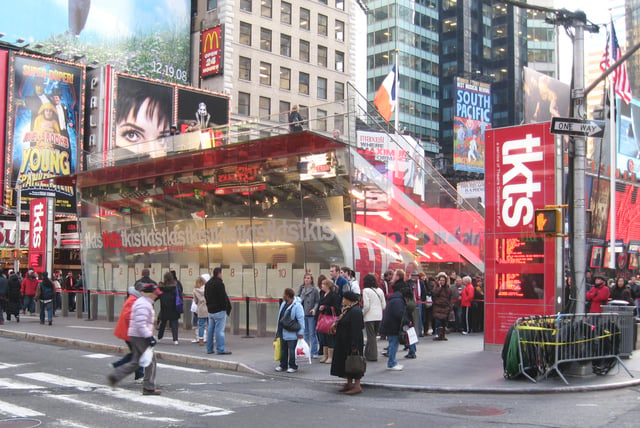
Looking southeast at TKTS ticket booth on a sunny afternoon in Times Square
In 2002, New York City mayor Rudy Giuliani administered the oath of office to the city's next mayor, Michael Bloomberg, at Times Square after midnight on January 1 as part of the 2001–2002 New Year's celebration. Approximately 500,000 revelers attended. Security was high following the September 11 terrorist attacks in 2001, with more than 7,000 New York City police officers on duty in the Square, twice the number for an ordinary year.[61]
Times Square started hosting major annual events in the 2000s. Since 2002, the summer solstice has been marked by "Mind over Madness", a mass yoga event involving up to 15,000 people. Tim Tompkins, co-founder of the event, said part of its appeal was "finding stillness and calm amid the city rush on the longest day of the year".[62][63] Architect Mark Foster Gage proposed and designed the original Times Square Valentine Day heart in 2009. Since then, designing the heart has become an annual competition.[64][65]
In February 2011, Times Square became smoke-free as New York extended the outdoors smoking ban to the area. The measure imposed a $50 fine for any person caught smoking within the area.[66]
From January 29 to February 1, 2014, a "Super Bowl Boulevard" was held on Broadway, especially in Times Square, between 34th and 47th Streets, as part of Super Bowl XLVIII. The boulevard contained activities such as autographs, a 60 feet (18 m)-high toboggan run, and photographs with the Vince Lombardi Trophy.[67][68][69] The area was under increased security and saw over 400,000 people during the period.[70]
Pedestrian plaza
On February 26, 2009, Mayor Michael Bloomberg announced that traffic lanes along Broadway from 42nd Street to 47th Street would be de-mapped starting Memorial Day 2009 and transformed into pedestrian plazas as a trial until at least the end of the year. The same was done in Herald Square from 33rd to 35th Street. The goal was to ease traffic congestion throughout the midtown grid. The results were to be closely monitored to determine if the project was successful and should be extended.[71] Bloomberg also stated that he believed the street shutdown would make New York more livable by reducing pollution, cutting down on pedestrian-vehicle accidents and helping traffic flow more smoothly.[72]
The pedestrian plaza project was originally opposed by local businesses, who thought that closing the street to cars would hurt business.[73] The original seats put out for pedestrians were inexpensive multicolored plastic lawn chairs, a source of amusement to many New Yorkers; they lasted from the onset of the plaza transformation until August 14, 2009, when they were ceremoniously bundled together in an installation christened Now You See It, Now You Don't by the artist Jason Peters, and shortly afterward were replaced by sturdier metal furniture.[74] Although the plaza had mixed results on traffic in the area, injuries to motorists and pedestrians decreased, fewer pedestrians were walking in the road, and the number of pedestrians in Times Square increased.[75] On February 11, 2010, Bloomberg announced that the pedestrian plazas would become permanent.[76]
The city started rebuilding the plaza in 2010, hiring the design and landscaping firm Snøhetta to permanently replace Broadway's roadway with custom-made granite pavers and benches.[77] By December 2013, the first phase of the Times Square pedestrian plaza had been completed at the southern end of the square in time for the Times Square Ball drop on New Year's Eve.[78] The project was originally intended to be completed by the end of 2015.[78] The entire project was finally completed just before New Year's Eve 2016.[79] Some safety bollards were also installed as part of the renovation in order to prevent vehicular attacks or collisions on the sidewalk.[80] After a fatal 2017 car crash, there were calls to install more bollards along Times Square.[81]
Times Square's pedestrian plaza is frequented by topless women (with painted breasts) called "desnudas", as well as costumed characters, who typically panhandle for tips.[82] The pedestrian plaza became a source of controversy in the summer of 2015 because of a large number of complaints about the topless women and panhandling characters.[83] Although neither of these activities was illegal, opponents believed that the panhandlers' presence was detrimental to quality of life in the area.[84] There were calls from Police Commissioner Bratton and Mayor Bill de Blasio to remove the plaza, although Manhattan Borough President Gale Brewer opposed the proposal.[84] In June 2016, work started on "pedestrian flow zones" where no one was allowed to loiter, as well as "activity zones" where costumed characters were allowed to perform.[85]
Incidents
There have been several incidents in Times Square:
On the morning of March 6, 2008, a small bomb caused minor damage, but there were no reported injuries.[86]
On May 1, 2010, Times Square was evacuated from 43rd to 46th Streets following the discovery of a car bomb. It was found to be a failed bombing.[87]
On May 18, 2017, a car crash at Times Square killed one person and injured 22 others.[88][89]
On August 7, 2019, shortly after the El Paso shooting and the Dayton shooting many people believed that a backfiring motorcycle was actually gunfire and caused a spontaneous evacuation of the area, which caused mass confusion and chaos and injured at least twelve people.[90]
Number of visitors
Times Square is the most visited place globally with 360,000 pedestrian visitors a day, amounting to over 131 million a year.[91] As of 2013, it had a greater attendance than do each of the Disney theme parks worldwide, with 128,794,000 visitors between March 2012 and February 2013, versus 126,479,000 for the Walt Disney World theme parks in Bay Lake, Florida, in 2012.[91][92]
Even excluding residents from the visitor count, Times Square is the world's second most visited tourist attraction, behind the Las Vegas Strip.[93] The high level of pedestrian traffic has resulted in $4.8 billion in annual retail, entertainment and hotel sales,[94] with 22 cents out of every dollar spent by visitors in New York City being spent within Times Square.[94][95]
New Year's Eve celebrations

The Times Square Ball in 2007
Times Square is the site of the annual New Year's Eve ball drop. About one million revelers crowd Times Square for the New Year's Eve celebrations, more than twice the usual number of visitors the area usually receives daily.[96] However, for the millennium celebration on December 31, 1999, published reports stated approximately two million people overflowed Times Square, flowing from 6th Avenue to 8th Avenue and all the way back on Broadway and Seventh Avenues to 59th Street, making it the largest gathering in Times Square since August 1945 during celebrations marking the end of World War II.[97]
On December 31, 1907, a ball signifying New Year's Day was first dropped at Times Square,[98] and the Square has held the main New Year's celebration in New York City ever since. On that night, hundreds of thousands of people congregate to watch the Waterford Crystal ball being lowered on a pole atop the building, marking the start of the new year. It replaced a lavish fireworks display from the top of the building that was held from 1904 to 1906, but stopped by city officials because of the danger of fire. Beginning in 1908, and for more than eighty years thereafter, Times Square sign maker Artkraft Strauss was responsible for the ball-lowering. During World War II, a minute of silence, followed by a recording of church bells pealing, replaced the ball drop because of wartime blackout restrictions. Today, Countdown Entertainment and One Times Square handle the New Year's Eve event in conjunction with the Times Square Alliance.[98]
A new energy-efficient LED ball debuted for the arrival of 2008, which was the centennial of the Times Square ball drop. The 2008/2009 ball is larger and has become a permanent installation as a year-round attraction, being used for celebrations on days such as Valentine's Day and Halloween.[98]
The New York City Department of Sanitation estimated that by 8 a.m. on New Year's Day 2014, it had cleared over 50 tons of refuse from the New Year's celebration, using 190 workers from their own crews and the Times Square Alliance.[99]
Notable landmarks

One Astor Plaza (1515 Broadway) is the headquarters of Viacom. It replaced the Astor Hotel in 1972, when Times Square redevelopment plans allowed oversized office towers if they included new theatres.[100]
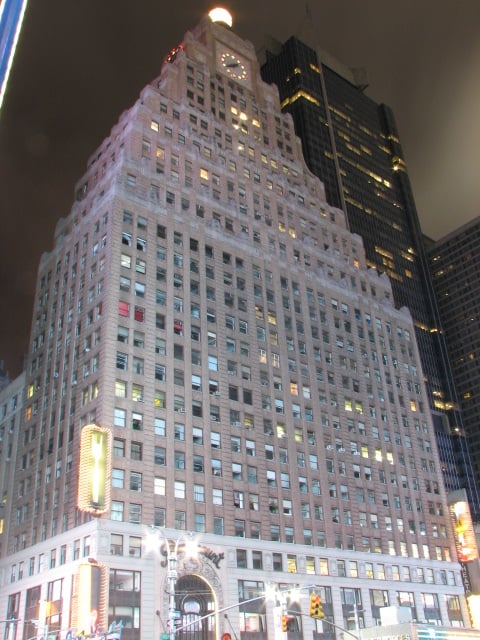
The Paramount Building at 1501 Broadway once housed the Paramount Theatre, where Frank Sinatra had bobby-soxers fainting in the aisles
Times Square is a busy intersection of art and commerce, where scores of advertisements – electric, neon and illuminated signs and "zipper" news crawls – vie for viewers' attention. Notable examples include;
Coca-Cola sign
Disney Store
Forever 21 (formerly Virgin Megastores)
Hard Rock Cafe New York
M&M's World
Planet Hollywood
PlayStation Theater
Times Square Studios (used primarily for selected ABC News and ESPN programs, such as Good Morning America)
TKTS booth
In popular culture
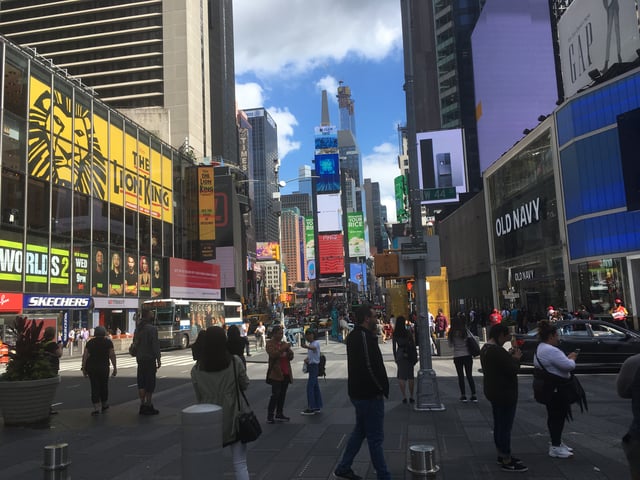
Times Square looking north from 44th Street

The northern part of the square in 2004 before reconstruction, with Two Times Square in the center
An immediately recognizable location, Times Square has been featured countless times in literature, on television, in films, in video games, and in music videos.
The seediness of the area was featured prominently in such films as Midnight Cowboy[102] (1969) and Taxi Driver (1976).[103] The area was shown in the 1980 film Times Square, which featured a punk rock/new wave soundtrack.[104] It was also depicted in the 2011 movie New Year's Eve.[105] The area also appeared on The Amazing Race as one of the locations in a race around the world, notably in the first episode of the show's 25th season.[106]
Times Square has been fictionally attacked and destroyed in a number of movies, including Knowing, when a solar flare destroys New York City;[107] Deep Impact, when a tsunami created from a meteor impact destroys New York City; the 1998 film Godzilla, where Godzilla is chased through the square; the Ghostbusters movies; Stephen King's The Stand, where the intersection is overcome by total anarchy; the ending of Captain America: The First Avenger;[108] and Transformers: Revenge of the Fallen. It was also seen in the festival battle scene in the 2002 film Spider-Man, and a stand-off in the later film The Amazing Spider-Man 2.[109]
Films and TV shows have also employed the opposite tactic, depicting the typically bustling area as eerily still, such as in Vanilla Sky,[110] as well as the post-apocalyptic I Am Legend, in which Will Smith and his dog go hunting for deer in the deserted urban canyon.[107] In the pilot episode of the TV series Blindspot, Times Square is completely emptied due to an abandoned bag being suspected to be a bomb.[111]
Times Square also has featured prominently in video games. For instance, in Grand Theft Auto IV, a recreation of the Times Square area, referred to in-game as "Star Junction", is included in the game's fictional "Liberty City" setting.[107] Times Square is also shown in Battlefield 3, where the final fight with the main antagonist takes place, where the player must stop him from detonating a nuclear bomb in the square; and Crysis 2, in which player must fight off attacking alien forces in order to assist U.S. Marines in evacuating the area.[112]
See also
In the Times Square area
Duffy Square, the northern section of Times Square between 45th and 47th Streets[113]
Good Riddance Day, an unofficial holiday celebrated at Times Square since 2007[114]
Midtown Community Court, a branch of the New York City Criminal Court that primarily focuses on quality of life around Times Square[115]
Naked Cowboy, New York City street performer and prominent fixture of Times Square[116]
Theater District, Manhattan[117]
Times Square – 42nd Street / Port Authority Bus Terminal subway station serving the 1, 2, 3, 7, <7>, A, C, E, N, Q, R, W, and S (42nd Street Shuttle) trains
Other
L.A. Live, a public square in downtown Los Angeles
Lincoln Highway, the terminus of which was in Times Square
Piccadilly Circus, a commercialized road junction in London
Yonge–Dundas Square, a public square in downtown Toronto

